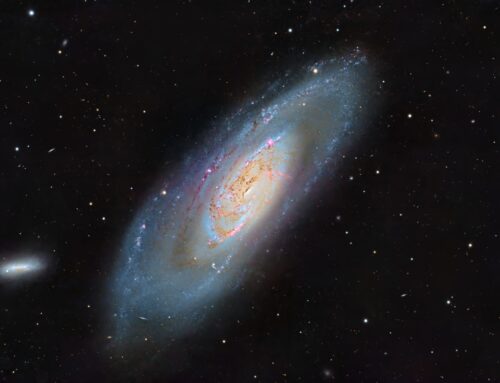Sharpless 2-115 (Hubble Palette)
 Click image for full size version
Click image for full size version
July 16, 2020; AAPOD July 21, 2020
Sh2-115 dominates the centre and right half of the image, with round Sh2-116 at upper left. Both are members of the Sharpless catalogue of nebulae and lie in northern Cygnus, not far from the famous North America nebula. They lie about 7500 light years away. The main nebula, which shows blue in this image, is powered by the stars in the open cluster Berkeley 90, which is slightly to the lower right of centre.
 The image above was acquired with narrowband filters that permit only a few specific wavelengths to pass through to the camera’s sensor. The light from the three filters is combined assigning sulfur to red, hydrogen to green and oxygen to blue, the so-called “Hubble palette.” The photo at left was made using the same hydrogen-alpha data, along with luminance and broadband colour data to make a more traditional natural-colour image of this object. Click on it to see its web post.
The image above was acquired with narrowband filters that permit only a few specific wavelengths to pass through to the camera’s sensor. The light from the three filters is combined assigning sulfur to red, hydrogen to green and oxygen to blue, the so-called “Hubble palette.” The photo at left was made using the same hydrogen-alpha data, along with luminance and broadband colour data to make a more traditional natural-colour image of this object. Click on it to see its web post.
Tekkies:
Sky-Watcher Esprit 150 f/7 refractor, QHY 16200-A camera, Optolong Ha, O3 and S2 filters, Paramount MX. Acquisition with TheSkyX unguided. Focus with Optec DirectSync motor and controller. Automation with CCDCommander. Equipment control with PrimaLuce Labs Eagle 3 Pro computer. All pre-processing and processing in PixInsight. Acquired from my SkyShed in Guelph. No Moon, average to above average transparency and average seeing. Data acquired July 14-16, 2020.
11x10m S2, 19x10m Ha, and 9x10m O3 (Total = 6hr00m)
Image scale 1.15 arcsec per pixel
Data Reduction and Cleanup
The WeightedBatchPreProcessing script was used to perform calibration, cosmetic correction, registration and integration of all frames. DynamicCrop was used to crop all the masters identically. DynamicBackgroundExtraction was applied to each master using Subtraction.
Chrominance
Creation and cleanup: The S2, Ha and O3 were combined to make an RGB image. BackgroundNeutralization was applied to the image.
Linear Noise Reduction: MultiscaleLinearTransform was used to reduce noise in the RGB image. Layer settings for threshold and strength: Layer 1: 4.0 0.8 Layer 2: 3, 0.7 Layer 3: 2., 0.6 Layer 4: 1.0, 0.2 Layer 5: 0.5, 0.1.
Stretching: HistogramTransformation was applied to make a pleasing, bright image, with background set to an intensity of approximately 0.125
Luminance
Creation of Synthetic Luminance: PixelMath was used to create a synthetic luminance using the expression max(max(Ha,S2),O3). The double “max” is not a typo.
Deconvolution: A star mask was made to use as a Local Deringing Support image. A copy of the luminance image was stretched to use as a range mask. Deconvolution was applied (80 iterations, regularized Richardson-Lucy, external PSF made using PSFImage script with about 30 stars).
Linear Noise Reduction: MultiscaleLinearTransform was used to reduce noise in the background areas, using an internal mask to protect bright structures. Layer settings for threshold and strength: Layer 1: 3.0 0.9 Layer 2: 2.0, 0.75 Layer 3: 1.0, 0.6 Layer 4: 0.5, 0.2.
Stretching: HistogramTransformation was applied to make a pleasing, bright image, with background set to an intensity of approximately 0.125.
Combining Luminance and RGB
LRGB Combination: The synthetic luminance was applied to the RGB image using LRGBCombine with default settings.
Additional Processing
Nonlinear Noise Reduction: TGVDenoise was used in L*a*b* mode to reduce noise with a mask used to mainly target the background areas and protect the stars(max. 1000 iterations and convergence selected for both luminance and chrominance).
Contrast Enhancement: LocalHistogramEqualization was applied twice using a mask to select the bright parts of the nebula and protect stars and background. The first pass was with a scale of 30 (max contrast 1.5, strength 0.52, 1 iteration), followed by a scale of 150 (max contrast 1.5, strength 0.22, 1 iteration).
Sharpening: MultiscaleLinearTransform was used to sharpen Layers 2 and 3 with strengths of 0.1 for both. A mask was used to limit sharpening to high-signal areas and to protect the stars and background regions.
Hue Adjustment: The ColorMask script was used to create a mask to select green regions. The green was transformed towards blue and yellows towards red using the Hue adjustment of CurvesTransformation. SCNR was then applied without the mask.
Final Steps: Background, nebula and star brightness, contrast, saturation and hue were adjusted in several iterations using CurvesTransformation with masks as required. ICCProfileTransformation (sRGB IEC61966-2.1; Relative Colorimetric with black point compensation) was applied prior to saving as a jpg.






Very interesting region, excellent job on bringing out all the faint dust and gas.
Thanks for all the details in your aquissition and processing. Every image is like a little tutorial. Nice image, BTW.